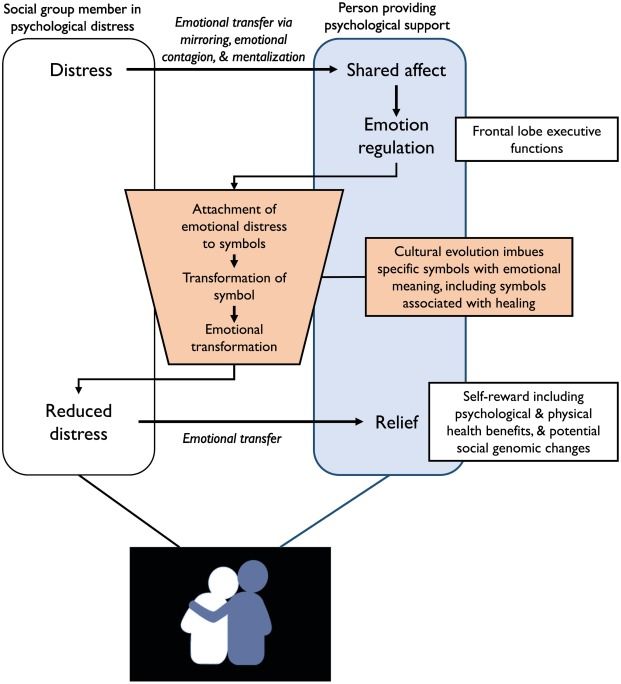Trauma
The Complete Guide to How We Help Each Other Heal
Healing is not a solo project. We help each other heal by offering consistent emotional support, safe connection, and attuned presence that calm the nervous system and reshape how the brain processes stress. When our relationships feel secure, our bodies regulate better, our thoughts soften, and recovery becomes not only possible, but sustainable.
In a world of chronic stress, global crises, and quiet personal battles, learning how to help each other is no longer optional—it’s foundational. This guide blends current neuroscience, evolutionary psychology, and practical tools so you can understand how connection heals and how to turn everyday interactions into a powerful support system.
Why Helping Each Other Heal Matters Now
Pain—grief, anxiety, burnout, trauma—is part of being human. What’s changed in 2025 is the intensity and visibility of that pain: social isolation, digital overload, climate anxiety, and global instability amplify our nervous systems.
The good news: our biology is wired for co-healing. Research shows that supportive relationships reduce stress hormones, stabilize heart rate, and improve immune function (Harvard, 2024). When we feel seen and safe with others, our bodies move out of survival mode and back into growth, repair, and connection.
"Connection isn’t a luxury; it’s a physiological need that directly shapes our capacity to heal."
Understanding this gives us a clear mission: build relationships and communities that actively help each other heal, moment by moment.
How Does Connection Heal the Brain and Body? (Quick Answer)
Here’s a concise overview for fast readers:
When we feel emotionally safe with someone we trust, our brain interprets that connection as protection. This safety reduces threat responses in the amygdala, supports regulation of our "body budget" (energy, hormones, inflammation), and strengthens neural pathways linked to resilience. Over time, regulated relationships can reshape trauma patterns and support long-term mental health.
The Science of How We Help Each Other Heal
1. The "Body Budget": Why Your Presence Matters
Our brains constantly manage a "body budget": energy, glucose, oxygen, hormones, and immune responses that keep us alive and balanced. We don’t regulate this alone—we do it together.
- A calm voice, eye contact, or steady breathing from someone we trust can lower our heart rate.
- Gentle touch or a reassuring message can reduce stress reactions and pain perception.
- Chronic loneliness, criticism, or conflict can deplete this budget and keep us in survival mode.
Stanford researchers highlight that high-quality relationships predict better cardiovascular, immune, and mental health outcomes, on par with major lifestyle factors. Every interaction is either a deposit or a withdrawal from someone’s body budget—and from our own.
2. Our Evolutionary Drive to Help Each Other
Human beings survived not by being the strongest, but by being the most connected. Emotional distress often evolved as a signal: "Something is off in the group—repair it."
Key principles:
- Emotions are social signals. Feelings like shame, grief, fear, or guilt often arise around relationships and belonging.
- Regulation is interpersonal. We learn to calm down, think clearly, and feel safe through caregivers, friends, and communities.
- Consoling behaviors are wired in. Empathy, perspective-taking, and emotional resonance help maintain group cohesion and safety.
When we help each other through attuned listening, comfort, and protection, we’re not just being kind—we’re activating an ancient survival system that supports psychological healing.

How Do Words Help Us Heal?
Words are not "just words." They are biologically active.
Language centers in the brain are linked to systems that regulate heart rate, metabolism, inflammatory responses, and emotional meaning-making. That means what we say—to ourselves and others—directly influences the body.
Short example:
- "You’re overreacting" can intensify shame and stress.
- "It makes sense you feel this way" can signal safety and reduce physiological arousal.
"Our daily conversations are tools for regulating each other’s bodies. Our words can inflame or soothe, constrict or expand."
Using gentle, accurate, validating language is one of the simplest ways we can help each other heal in real time.
What Is Collective Healing and Why Is It Crucial?
Collective trauma arises when communities face war, injustice, pandemics, disasters, or generational oppression. Its impact shows up in distrust, polarization, burnout, and a constant sense of unsafety.
Collective healing recognizes that:
- Many of our reactions are not only personal, but inherited or shared.
- Systems, cultures, and communities can either retraumatize or repair.
- Healing accelerates when we create spaces where experiences are witnessed, named, and held together.
When groups practice empathy, accountability, and attuned dialogue, they help each other repair trust, restore a sense of belonging, and interrupt the transmission of trauma to future generations.
People Also Ask: How Do We Help Each Other Heal?
How can we help each other heal emotionally? (Featured Answer)
We help each other heal emotionally by offering consistent presence, nonjudgmental listening, and validating feelings instead of fixing or minimizing them. Simple actions—checking in regularly, mirroring emotions with care, and respecting boundaries—signal safety to the nervous system and build the trust required for deeper healing.
Key practices:
- Listen more than you speak.
- Say what you see: "You’ve been carrying a lot."
- Acknowledge pain without rushing to solutions.
- Ask: "What would feel supportive right now?"
How does empathy support healing?
Empathy is our capacity to feel with and understand another person’s inner world.
Empathy helps healing by:
- Reducing feelings of isolation and shame.
- Allowing accurate support—because we sense what the other truly needs.
- Encouraging healthier behaviors through feeling genuinely cared for.
Empathy combines emotional resonance (feeling with) and perspective-taking (understanding why). Both are essential for meaningful support.
Can relationships really change the brain?
Yes. Repeated experiences of safety, respect, and care literally reshape neural pathways.
Supportive relationships can:
- Lower chronic stress activation.
- Build new associations of "closeness = safe" instead of "closeness = danger."
- Strengthen prefrontal regions involved in reflection and self-control.
Over time, this can soften trauma responses and increase resilience.
What does it mean to be "attuned" to someone?
Attunement is the skill of tuning into another person’s emotional state with curiosity and care.
It looks like:
- Noticing subtle cues: tone, posture, energy.
- Adjusting your response—slowing down, softening your voice, giving space.
- Staying present without trying to control or rush them.
Attunement is one of the most powerful ways we help each other feel safe, seen, and supported.
Core Pillars: How We Help Each Other Heal in Daily Life
1. Safe Presence
Healing relationships start with one message: "You are safe with me."
Ways to offer safe presence:
- Maintain soft eye contact and open body language.
- Avoid interrupting or interrogating.
- Keep confidences; don’t weaponize vulnerability.
2. Emotionally Honest Communication
Honest, kind communication creates clarity instead of confusion.
Try:
- "I’m here with you."
- "Your feelings are valid."
- "We’ll move through this step by step."
Avoid dismissive phrases like "It’s not a big deal" or "Just be positive." These can increase distress and erode trust.
3. Co-Regulation of the Nervous System
Co-regulation is how our bodies sync up with others.
Helpful strategies:
- Sit together and take slow, deep breaths.
- Use a calm, steady tone.
- Offer grounding: "Can you feel your feet on the floor while we talk?"
These simple actions can help someone move from overwhelm back to stability.
4. Respecting Boundaries and Autonomy
Support is healing when it honors choice.
- Ask for consent before diving into heavy topics.
- Accept "no" as an act of self-respect, not rejection.
- Offer options instead of instructions.
Respecting boundaries transforms support from control into collaboration.
5. Belonging and Community
We heal faster when we don’t feel alone.
Communities that help each other heal tend to:
- Normalize conversations about mental health.
- Create rituals of check-ins, circles, or shared practices.
- Celebrate progress, not just outcomes.
Digital spaces, support groups, workplaces, and families can all become micro-ecosystems of healing when designed with care.
New Everyday Examples of Healing in Action
Here are real-world ways people are using connection to support recovery:
- A remote team opens each meeting with a two-minute "emotional weather" check-in, reducing burnout and misunderstandings.
- A group of neighbors hosts a monthly "quiet dinner" where phones are off and everyone can share one real thing they’re going through—no fixing, just listening.
- A university peer-support circle trains students in basic trauma-sensitive listening so classmates have safe places to land during crises.
Each of these practices helps people support one another, regulate stress, and rebuild trust.
Practical Ways to Help Each Other Heal (You Can Start Today)
Use these simple but powerful approaches in your relationships.
Be fully present
- Put your phone away when someone shares something vulnerable.
- Offer your full attention for even five focused minutes.
Validate before you advise
- Start with: "It makes sense you feel this way."
- Only offer suggestions after asking: "Would you like ideas or just a listening ear?"
Mirror calm, not panic
- Slow your breathing.
- Speak gently and clearly.
- Ground in the present: "Right now, in this moment, you’re not alone."
Check in regularly
- Send a short message: "Thinking of you—no need to reply."
- Follow up after hard days, anniversaries, or major changes.
Encourage professional support
- Normalize therapy and support groups.
- Offer to help find resources or sit with them before/after sessions if they’d like.
Step-by-Step: How to Create a Micro-Ecosystem of Healing
Turn your relationships, family, or team into a supportive environment.
Name the intention
- Share: "I want this space to be one where we can be honest, supported, and real."
Set simple agreements
- No shaming or mocking.
- Confidentiality is respected.
- We ask before giving advice.
Practice attuned listening
- One person speaks at a time.
- Others reflect back what they heard.
- Feelings are acknowledged, not debated.
Build small rituals
- Weekly check-in call.
- One family meal where everyone shares a high and low.
- Team mindfulness or breathing minute before big decisions.
Repair quickly when there’s a rupture
- If you snap or withdraw, circle back.
- Say: "I’m sorry for how I spoke. Your feelings matter; can we try again?"
Keep learning together
- Explore resources on trauma, nervous system regulation, and communication.
- Talk about what each of you finds helpful or unhelpful.
These steps, repeated over time, create a stable network where people naturally help each other heal, instead of coping alone.
Key Takeaways
- We are biologically and emotionally wired to help each other heal; connection is a core regulator of our stress, mood, and resilience.
- Supportive relationships act like an extension of our immune and nervous systems, influencing how we process pain, trauma, and daily stress.
- Words, presence, and attunement are powerful tools—seemingly small interactions can either deepen wounds or accelerate healing.
- Collective healing matters: when communities practice empathy, accountability, and inclusion, they reduce the transmission of trauma across generations.
- You don’t need to be a therapist to make a difference; by listening deeply, respecting boundaries, and showing up consistently, you become part of a living ecosystem of repair.
Healing is a shared practice. Every time we choose curiosity over judgment, listening over fixing, and compassion over avoidance, we quietly change someone’s world—and our own.





